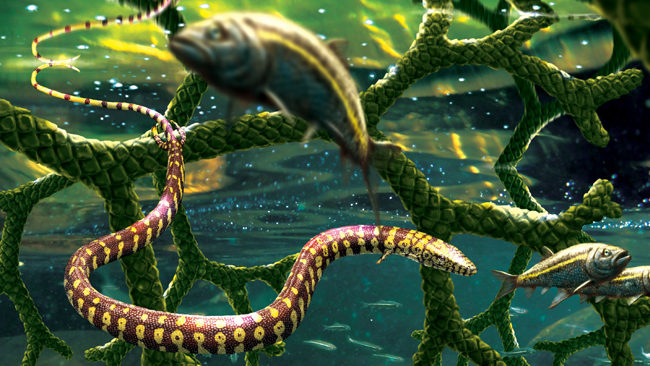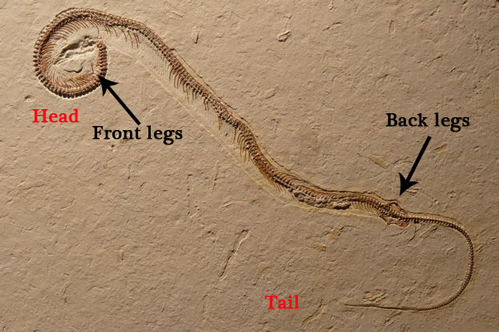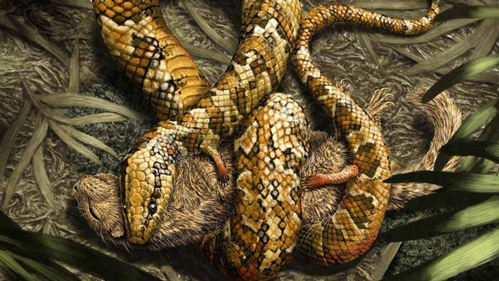The Early Cretaceous Tetrapodophis amplectus, once thought to represent an early limbed snake, was not a snake after all, but a member of the Dolichosauridae. The fossil is not a missing link between lizards and snakes but an aquatic lizard. That was the conclusion in a paper published late last year (2021) and today we take a look at this remarkable and highly controversial fossil specimen.

A life reconstruction of Tetrapodophis amplectus gliding through cover as it stalks fish close to the shore. New research suggests that this Early Cretaceous reptile is not a transitional form between a lizard and a snake, but instead it is a dolichosaurid. Picture credit: Julius Csotonyi.
Picture credit: Julius Csotonyi
A Transitional Fossil
Palaeontologists had long hoped to find a transitional fossil showing a lizard-like animal with vestigial limbs, an evolutionary link in the evolution of snakes from a limbed ancestor. Tetrapodophis was named in 2015, when a scientific paper was published describing a remarkable fossil from Brazil that had been spotted quite by chance by scientists on a visit to a German museum.
To read Everything Dinosaur’s 2015 article about the T. amplectus scientific paper: Fossil Snake with Four Limbs Described.
Had Tetrapodophis been revealed to be an ancestral snake then this would have had very significant implications for our understanding of the evolution of the Squamata. However, in November 2021 a scientific paper was published in the “Journal of Systematic Palaeontology” which concluded that the fossil had been misidentified. The research team from the University of Alberta, Harvard University, Flinders University (South Australia), the University of Toronto, Midwestern University and the Universidad Maimónides (Buenos Aires, Argentina), examined the counter slab and concluded that the fossil skull impression did not demonstrate characteristics typically seen in snake skulls.

A beautifully preserved specimen once thought to represent an early, limbed snake but now thought to be a marine lizard related to snakes and modern lizards. Picture credit: Dr Dave Martill/University of Portsmouth with additional annotation by Everything Dinosaur.
Picture credit: Dr Dave Martill/University of Portsmouth with additional annotation by Everything Dinosaur
University of Alberta palaeontologist Michael Caldwell, who led the study commented:
“When the rock containing the specimen was split and it was discovered, the skeleton and skull ended up on opposite sides of the slab, with a natural mould preserving the shape of each on the opposite side. The original study only described the skull and overlooked the natural mould, which preserved several features that make it clear that Tetrapodophis did not have the skull of a snake — not even of a primitive one.”

In the original 2015 scientific description, Tetrapodophis was thought to be an ancestral snake. The tiny limbs were thought to have been used to hold prey. Scientists were uncertain whether this animal was a burrower or adapted to a marine environment. It has now been assigned to the Dolichosauridae. Picture credit: Julius Csotonyi.
Picture credit: Julius Csotonyi
Squamata Evolution Remains Ambiguous
The evolution of the Order Squamata remains ambiguous. It is thought that the first, basal squamates evolved during the Middle Triassic, but when the first true snakes evolved is uncertain. The 2021 paper examining the skull impression in the counter slab confirmed that Tetrapodophis lacked typical snake skull characteristics. The spine was also shown to lack typical snake-like anatomical traits.
The fossil record for the Squamata is particularly sparse. Primitive snake and lizard skeletons are usually small with delicate bones that are easily dispersed post-mortem. Palaeontologists hope that more fossils will be found that help to clarify the evolutionary origins of snakes.
A Controversial Fossil
Tetrapodophis amplectus may not represent a snake with four legs, transitional fossils remain elusive, it still has immense scientific value. Co-author of the 2021 paper, Tiago Simões (Harvard University) explained:
“One of the greatest challenges of studying Tetrapodophis is that it is one of the smallest fossil squamates ever found. It is comparable to the smallest squamates alive today that also have reduced limbs.”
The fossil specimen remains controversial. The fossil, originally from Brazil may have been exported without the appropriate permits. It was part of a private collection and the authorities in Brazil only became aware of the fossil’s existence when the 2015 paper was published.
Tetrapodophis
To read an article about the legal dispute: Fossil Slithers into Legal Dispute.
Everything Dinosaur acknowledges the assistance of media releases from Flinders University and the University of Alberta in the compilation of this article.
The scientific paper: “Tetrapodophis amplectus is not a snake: Reassessment of the osteology, phylogeny and functional morphology of an Early Cretaceous dolichosaurid lizard” by M. W. Caldwell, T. R. Simões, A. Palcid, F. F. Garberoglio, R. R. Reisz, M. S. Y. Lee and R. L. Nydam published in the Journal of Systematic Palaeontology (November 2021).
The Everything Dinosaur website: Dinosaur Toys.






Leave A Comment